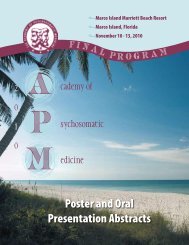Table of Contents - Academy of Psychosomatic Medicine
Table of Contents - Academy of Psychosomatic Medicine
Table of Contents - Academy of Psychosomatic Medicine
You also want an ePaper? Increase the reach of your titles
YUMPU automatically turns print PDFs into web optimized ePapers that Google loves.
Methods: Medical records <strong>of</strong> patients who received standardized<br />
evaluations by an outpatient PM consultation team<br />
during 2008 were reviewed. Records with complete domains<br />
<strong>of</strong> clinical data were classified into four groups based on diagnostic<br />
findings from the Mini-International Neuropsychiatric<br />
Interview (MINI): a) generalized anxiety disorder or panic<br />
disorder with no concurrent mood or somat<strong>of</strong>orm disorders<br />
(ANX), b) non-psychotic major depressive disorder with no<br />
concurrent anxiety or somat<strong>of</strong>orm disorders (DEP), c) somat<strong>of</strong>orm<br />
disorder or psychological factors affecting medical<br />
condition with no concurrent mood or anxiety disorders<br />
(SOM), and d) concurrent anxiety, depressive, and somat<strong>of</strong>orm<br />
disorders (COMB). A descriptive analysis was conducted<br />
that compared the 4 groups on the following variables:<br />
demographics, reason for consult, number <strong>of</strong> medication<br />
trials by medication category, psychiatric rating scale scores,<br />
number <strong>of</strong> past psychiatric or addiction hospitalizations, pain<br />
rating, abuse history, family history, perceived support, clinical<br />
psychiatric diagnosis, and treatment recommendations.<br />
Categorical data were analyzed with the Mantel-Haenszel<br />
chi-square test. Continuous data were analyzed with the<br />
student’s t-test. Level <strong>of</strong> statistical significance was set at<br />
p=.05.<br />
Results: Among 153 patients with complete sets <strong>of</strong> clinical<br />
data, the most frequent MINI-derived diagnoses were major<br />
depressive disorder (49.7%), somat<strong>of</strong>orm disorder (39.9%),<br />
generalized anxiety disorder (35.9%), psychological factors<br />
affecting medical condition (24.8%), and panic disorder<br />
(19.6%). 136 patients (88.9%) had at least one <strong>of</strong> these diagnoses.<br />
Twelve patients (7.8%) met criteria for assignment<br />
to the ANX group, 20 (13.1%) to the DEP group, 33 (21.6%)<br />
to the SOM group, and 23 (15.0%) to the COMB group.<br />
Pairwise group comparisons found significant differences<br />
in 42 demographic or clinical variables. The COMB group<br />
had higher symptom severity scores or greater pathological<br />
findings than other groups for 18 <strong>of</strong> these 42 variables. The<br />
ANX group had more severe findings for 17 variables, the<br />
DEP group for 5 variables, and the SOM group for 2 variables.<br />
The DEP and SOM groups did not fare worse than<br />
the ANX or COMB groups on any head-to-head comparison.<br />
Compared to the ANX, DEP, and SOM groups, COMB<br />
patients had higher mean Beck Depression Inventory (BDI)<br />
scores (26.3 v 20.8, 18.7, 11.8, p



